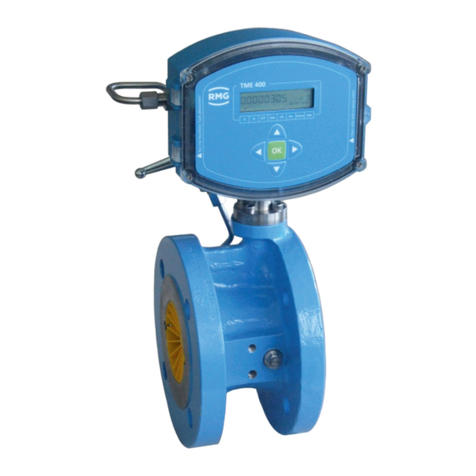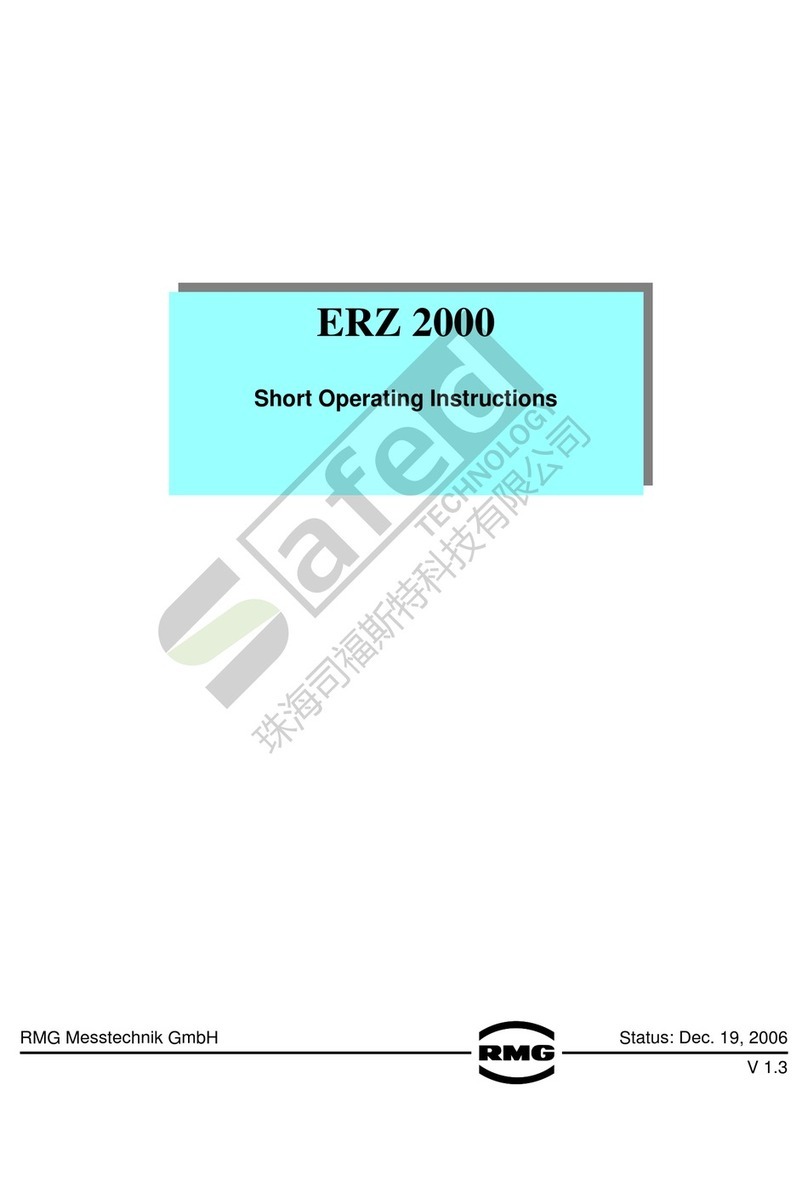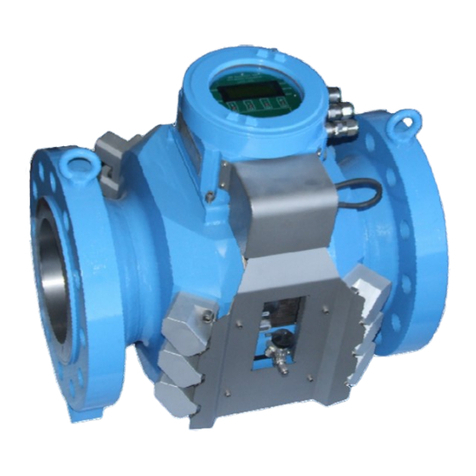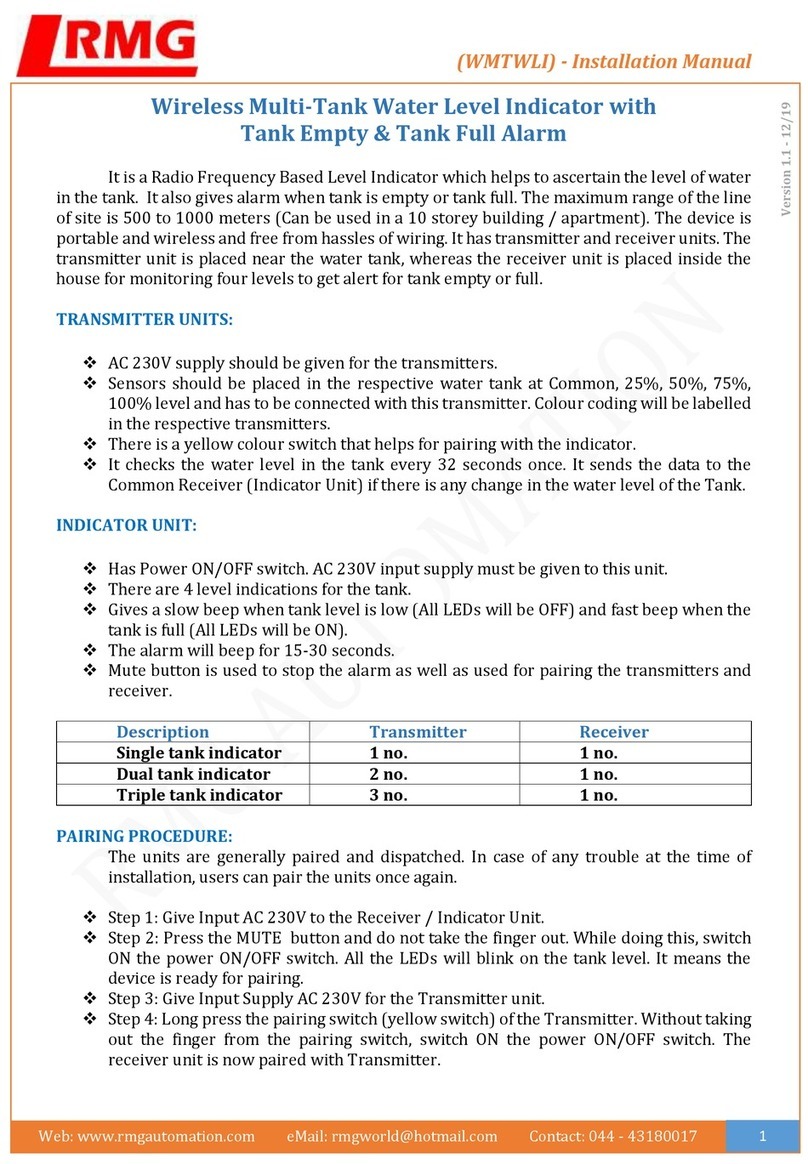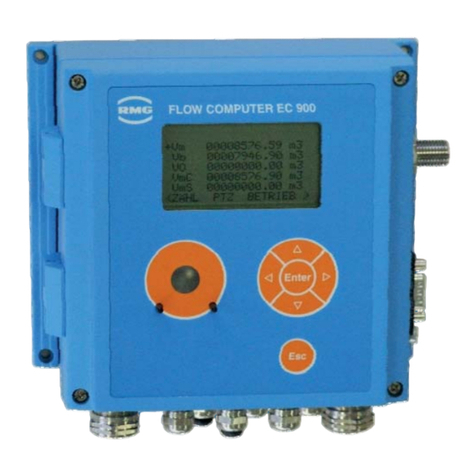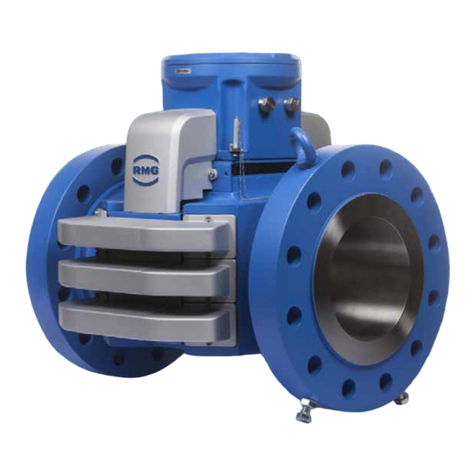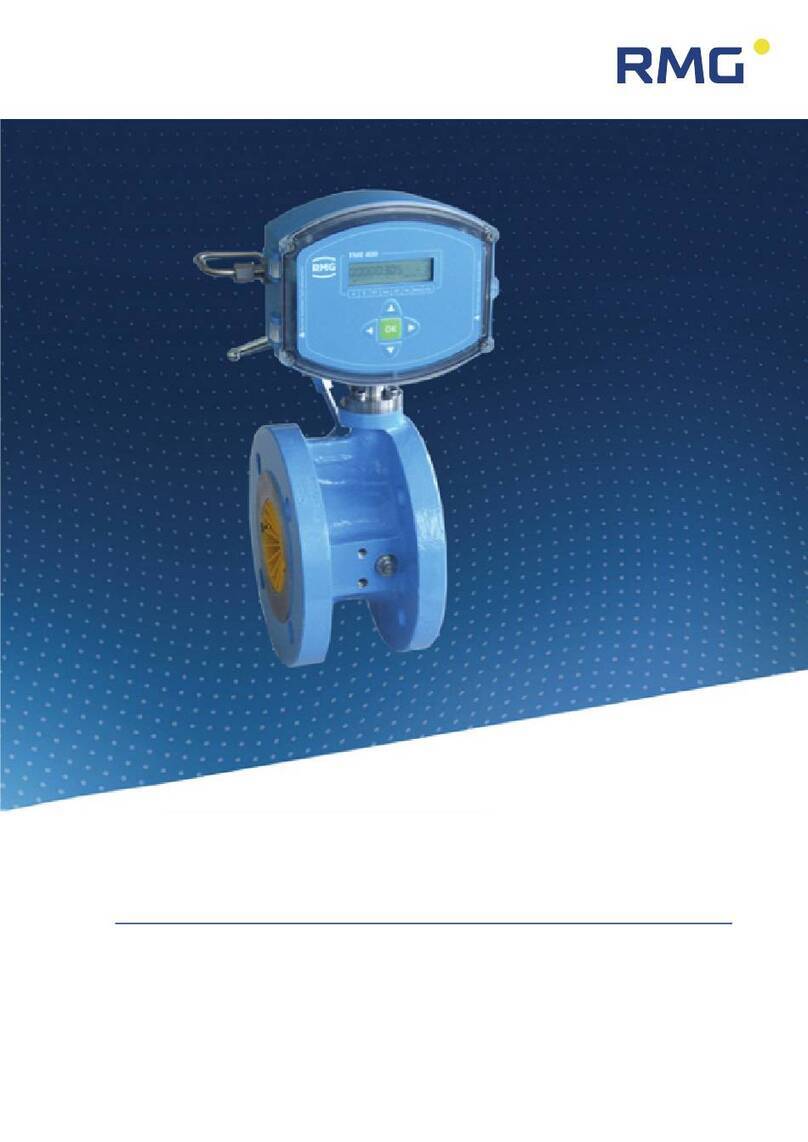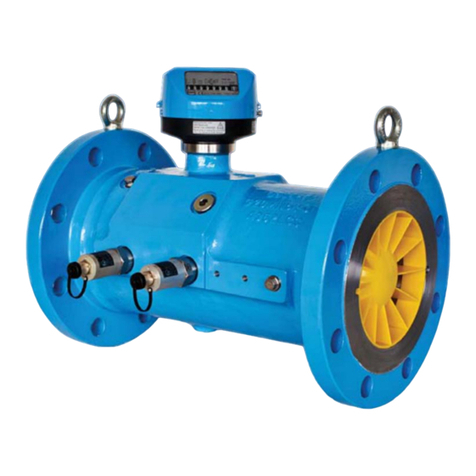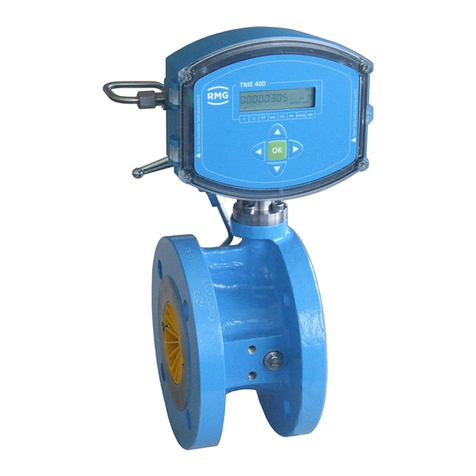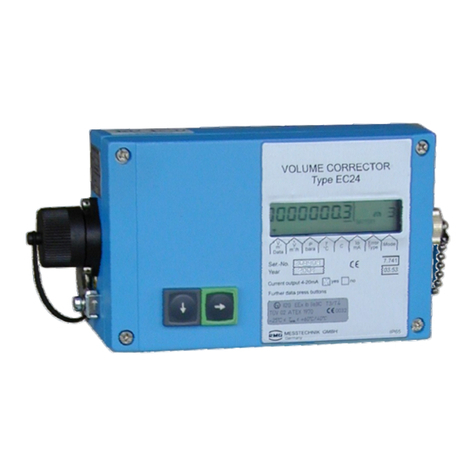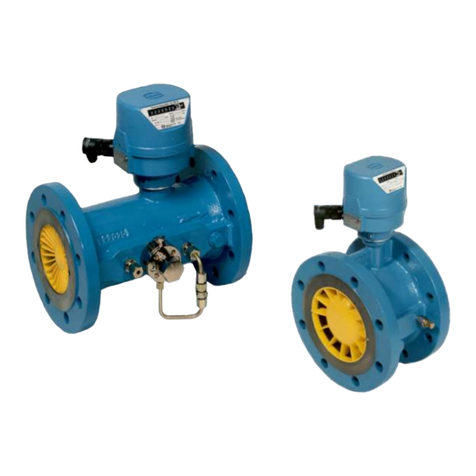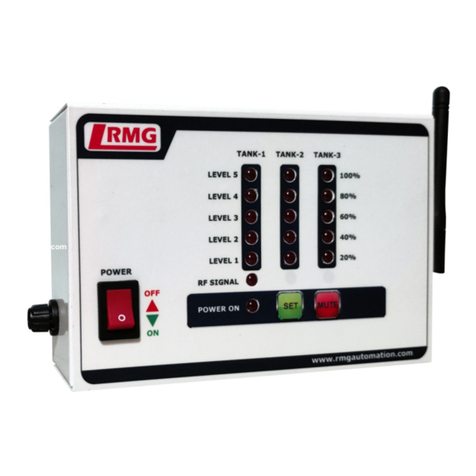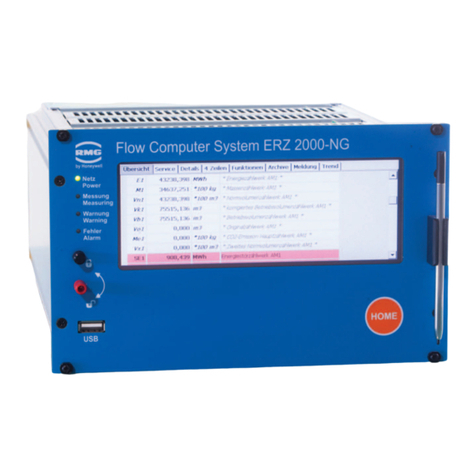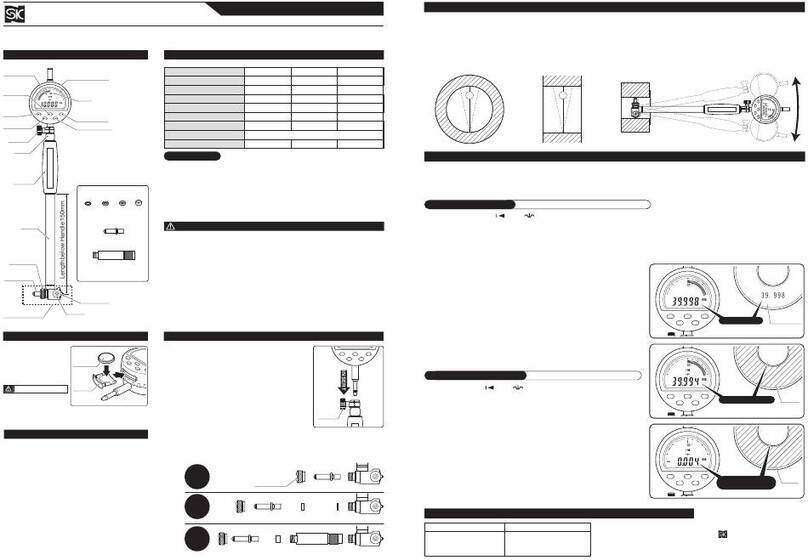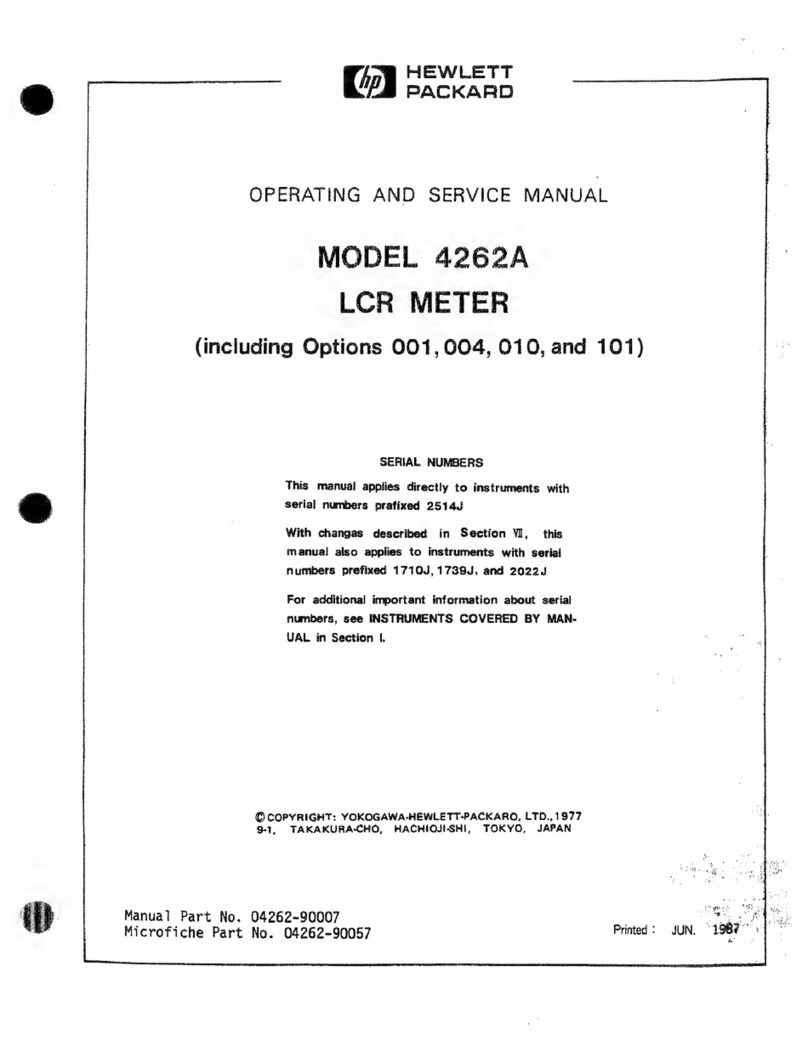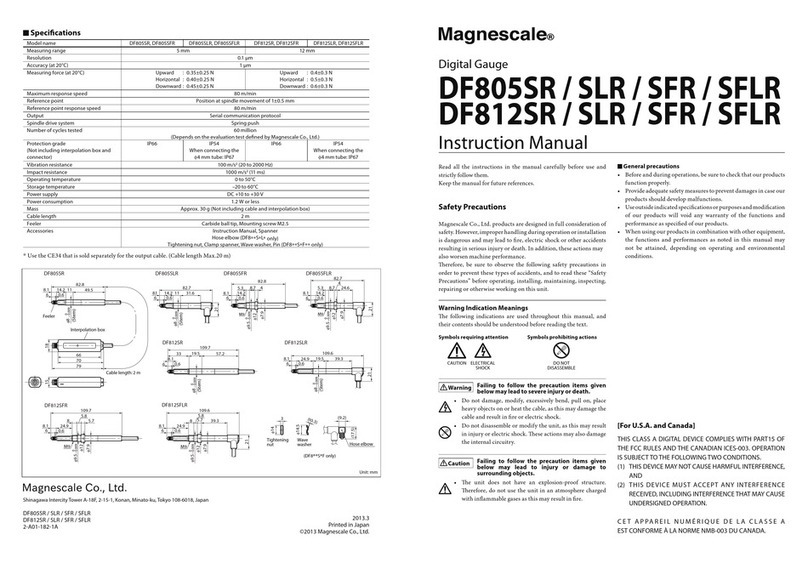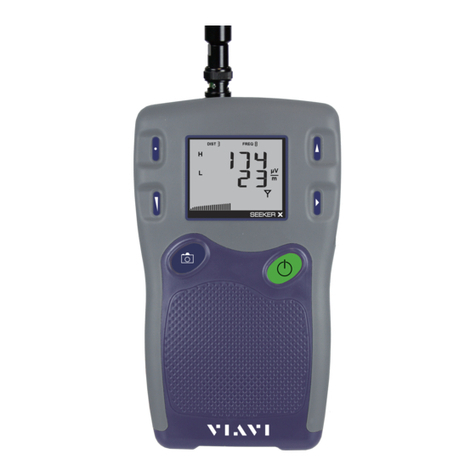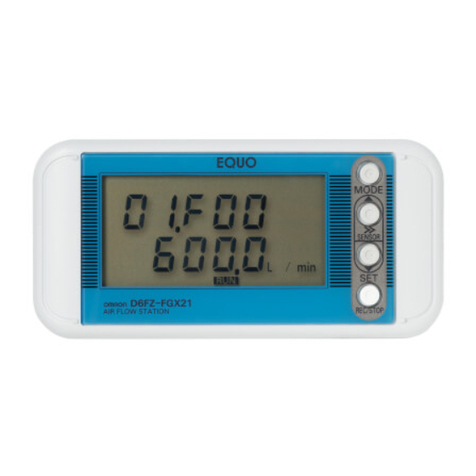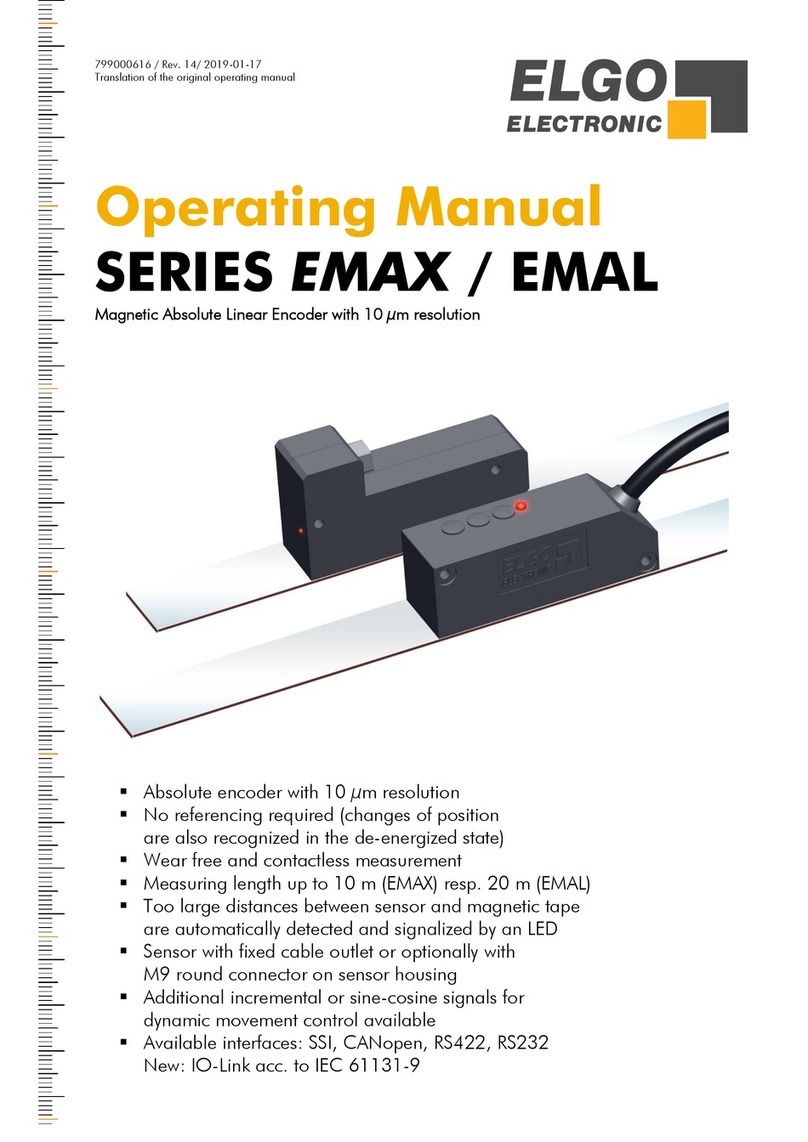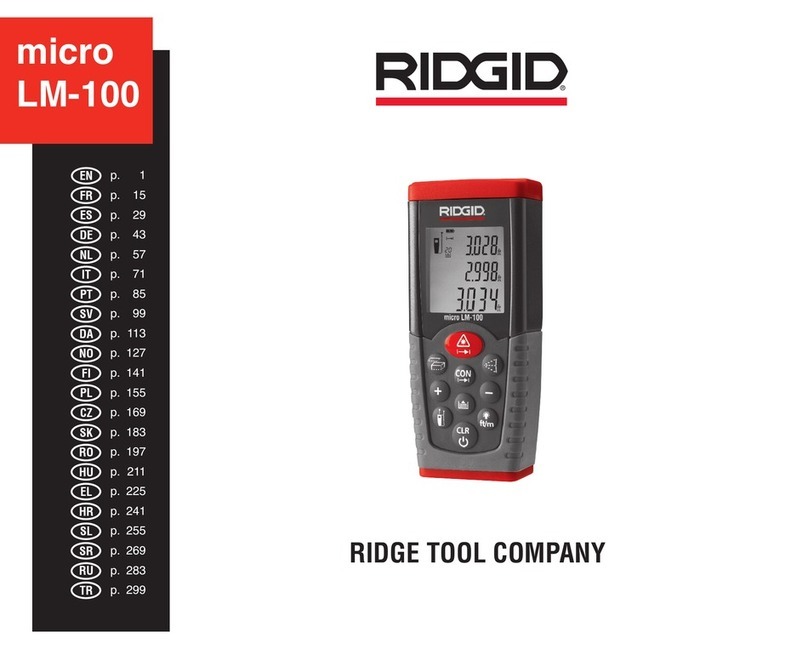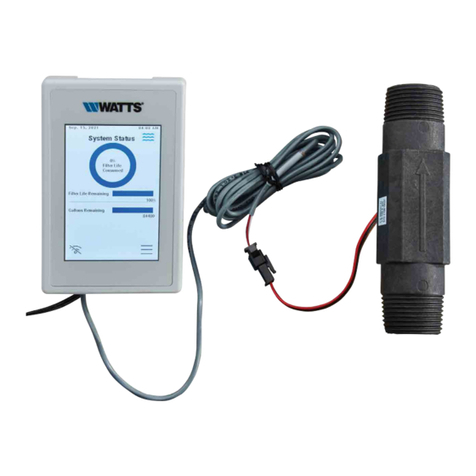RMG PGC 9300 User manual

PGC 9300 –Measuring Element
OPERATING MANUAL
Reliable Measurement of Gas
Status: June, 18th 2018
Version: 07

Contact
Manual PGC 9300 EN07 June, 18th 2018
Manufacturer
Our customer service is available for technical queries
Address
RMG Messtechnik GmbH
Otto-Hahn-Straße 5
35510 Butzbach, Germany
Main office
+49 6033 897 –0
Service
+49 6033 897 –0
Spare parts
+49 6033 897 –173
Fax
+49 6033 897 –130
Email
Translation of the
original document
The PGC9300_ME_manual_en_07 for the gas chromato-
graph PGC 9300 from June, 18th 2018 is a translation of
the original German manual. Anyhow, this document may
serve as reference for translations into other languages.
Remark:
Please use in case of any uncertainties the German ver-
sion as main reference.
Note
Unfortunately, paper is not updated automatically,
whereas technical development continuously advances.
Therefore, we reserve the right to make technical
changes in regard to the representations and specifica-
tions of these operating instructions. The latest version
of this manual (and the ones of other devices) can be
downloaded at your convenience from our Internet
page.
www.rmg.com.
Created
AUGUST 2012
1. Revised
MARCH 2013
2. Revised
SEPTEMBER 2013
3. Revised
MARCH 2015
4. Revised
May 2016
5. Revised
January 2018
6. Revised
June, 18th 2018
Document version and
language
Document version
PGC9300_ME_manual_en_07
June, 18th 2018
Language
EN

Contents
Manual PGC 9300 EN07 June, 18th 2018
I
Contents
1ABOUT THIS MANUAL......................................................................... 1
1.1 Structure of this manual......................................................................................1
1.2 Objective of this manual......................................................................................2
1.2.1 Abbreviations............................................................................................................... 2
1.2.2 Symbols........................................................................................................................ 2
1.2.3 Layout of instructions.................................................................................................. 2
1.2.4 Working with the device ............................................................................................. 3
1.2.5 Risk assessment and minimization........................................................................... 9
1.2.6 Validity of the manual ............................................................................................... 10
1.2.7 Transport.................................................................................................................... 11
1.2.8 Scope of delivery....................................................................................................... 12
1.2.9 Disposal of packaging material ............................................................................... 13
1.2.10 Storage ................................................................................................................... 13
1.3 Explosion-proof design.....................................................................................15
1.3.1 General information .................................................................................................. 15
1.3.2 Pressure-proof housing............................................................................................ 15
1.3.3 Connection housing with elevated safety............................................................... 16
1.4 Inspection and maintenance tasks.................................................................17
1.4.1 General information .................................................................................................. 17
1.4.2 Draining condensate from the measuring element............................................... 19
1.4.3 Changing carrier gas cylinders................................................................................ 19
1.4.4 Replacing the carrier gas filter................................................................................. 22
2QUICK GUIDE....................................................................................... 26
2.1 Mechanical connection......................................................................................26
2.2 Electrical connection .........................................................................................28
2.3 Commissioning ...................................................................................................28
3GAS CHROMATOGRAPH PGC 9300 .............................................. 29
3.1 Type designation.................................................................................................29
3.2 Mode of operation...............................................................................................31
3.3 Configuration of the measuring element unit ..............................................33
3.4 Gas flow distribution..........................................................................................36
3.5 Gas chromatograph............................................................................................37
3.6 Analysis process.................................................................................................40
3.7 Separating columns ...........................................................................................44

Contents
Manual PGC 9300 EN07 June, 18th 2018
II
3.8 Area of applicability............................................................................................44
3.9 Data acquisition and evaluation......................................................................44
3.9.1 Basic principles of the analysis................................................................................ 44
3.10 Required gases and gas consumption.......................................................46
3.10.1 Carrier gas.............................................................................................................. 46
3.10.2 Calibration gas....................................................................................................... 46
3.10.3 Sample gas ............................................................................................................ 47
4CONNECTION AND COMMISSIONING........................................... 49
4.1 Electrical connections .......................................................................................49
4.2 Gas connections .................................................................................................51
4.2.1 Carrier gas connection ............................................................................................. 52
4.2.2 Sample gas / calibration gas / reference gas connection..................................... 53
4.3 Column supply pressure and column temperature....................................53
4.4 Further process...................................................................................................53
4.5 Interruption of the carrier gas supply............................................................55
5OPERATING MODES OF THE DEVICE........................................... 57
5.1 Automatic operation...........................................................................................57
5.2 Stop mode.............................................................................................................57
5.3 Normal calibration ..............................................................................................57
5.4 Reference gas analysis......................................................................................57
5.5 Basic calibration..................................................................................................58
APPENDIX 1: TECHNICAL DATA.......................................................... 59
APPENDIX 2: ERROR MESSAGES....................................................... 68
Appendix 2 A: Error during operation .....................................................................68
Appendix 2 B: Errors during recalibration..............................................................69
Appendix 2 C: Mains failure of the GC 9300...........................................................69
APPENDIX 3: PRE-FILTER FLUSHING UNIT...................................... 70
APPENDIX 4: CERTIFICATES................................................................ 75

1About this manual
Manual PGC 9300 EN07 June, 18th 2018
1
1 About this manual
1.1 Structure of this manual
The introduction of this manual essentially comprises three parts. The first part of
the introduction lists general specifications, the symbols used in the manual and
the structure of notices are presented and a risk assessment is provided. It also in-
cludes specifications for transport and storage of the gas chromatograph PGC
9300.
The PGC 9300 can be operated in explosion-protected zones. The second part of
the introduction covers the conditions that must be observed for operation in such
areas and describes the explosion protection.
The third part of the introduction describes recurrent inspection and maintenance
tasks. Since the PGC 9300 “consumes” gases in order to be able to conduct an
analysis of the gas components, these regular maintenance tasks are necessary
for the proper function of the PGC 9300.
The second chapter provides brief instructions for connecting the PGC 9300. In
particular, the electrical and mechanical connections are sketched. The “correct”
starting up then takes place together with the controller of the GC 9300 and is de-
scribed in the manual of this GC 9300.
The method of operation and the intended use of the PGC 9300 are described in
the third chapter. The fourth chapter describes the electrical and mechanical con-
nections and relevant conditions for further operation. Automated operation and
the various calibrations during operation are covered in chapter 5.
The appendix contains the technical data, error messages, information about a
flushing unit pre-filter, sample circuit diagrams and a summary of the approvals.

1About this manual
Manual PGC 9300 EN07 June, 18th 2018
2
1.2 Objective of this manual
This manual provides information that is necessary for error-free and safe opera-
tion.
The gas chromatograph PGC 9300 was designed and produced according to the
state of the art and generally recognized safety standards and directives. How-
ever, its use can entail dangers that can be avoided by complying with this man-
ual. The gas chromatograph PGC 9300 must only be used as intended and in
technically sound condition.
Caution
Unintended use voids all warranty claims and the gas chromatograph PGC
9300 can also lose its approvals.
1.2.1 Abbreviations
The following abbreviations are used:
max.
Maximum
MID
Measurement Instruments Directive
min.
Minimum
e.g.
for example
1.2.2 Symbols
The following symbols are used:
1, 2, …
Identifies steps for work tasks
..
1.2.3 Layout of instructions
The following notices are used:

1About this manual
Manual PGC 9300 EN07 June, 18th 2018
3
Danger
This warning notice informs you of imminently threatening dangers that
can arise due to misuse/operator error. If these situations are not avoided,
death or severe injuries can occur.
Warning
This warning notice informs you of potentially dangerous situations that
can arise due to misuse/operator error. If these situations are not avoided,
minor injuries can occur.
Caution
This notice informs you of potentially dangerous situations that can arise
due to misuse/operator error. If these situations are not avoided, damage
to the device or nearby property can occur.
Note
This notice provides you with helpful tips to make your work easier. This
notice also provides you with further information about the device or the
work process in order to prevent operator error.
1.2.4 Working with the device
1.2.4.1 Safety instructions Danger, Warning, Caution and Note
Danger
All of the following safety notices must be observed!
Disregard of the safety notices can result in danger to the life and limb or environ-
mental and property damage.
Bear in mind that the safety warnings in this manual and on the device cannot
cover all potential dangerous situations, because the interaction of various condi-

1About this manual
Manual PGC 9300 EN07 June, 18th 2018
4
tions can be impossible to foresee. Merely following the instructions may not suf-
fice for correct operation. Always remain attentive and consider potential conse-
quences.
•Read this operating manual and especially the following safety notices care-
fully before working with the device for the first time.
•Warnings are provided in the operating manual for unavoidable residual
risks for users, third parties, equipment or other property. The safety in-
structions used in this manual do not refer to unavoidable residual risks.
•Only operate the device in fault-free condition and in observance of the op-
erating manual.
•Compliance with local statutory accident prevention, installation and assem-
bly regulations is also mandatory.
Caution
All notices in the manual must be observed.
Use of the gas chromatograph PGC 9300 is only permitted in accordance
with the specifications in the operating manual.
RMG assumes no liability for damages arising due to disregard of the op-
erating manual.
Danger
Service and maintenance tasks or repairs that are not described in the op-
erating manual must not be carried out without prior consultation with the
manufacturer.
Observe the following, in particular:
•Changes to the gas chromatograph PGC 9300 are not permitted.
•The technical specifications must be observed and followed for safe opera-
tion (Appendix 1: Technical data). Performance limits must not be ex-
ceeded.
•For safe operation, the gas chromatograph PGC 9300 must only be used in
the scope of the intended use (Chapter 3 Gas chromatograph PGC 9300
and 3.8 Area of applicability)

1About this manual
Manual PGC 9300 EN07 June, 18th 2018
5
•The PGC 9300 complies with current standards and regulations. However,
danger can arise with misuse and the measuring element of the PGC 9300
can be destroyed due to operator error.
1.2.4.2 Dangers during commissioning
Initial commissioning
The initial commissioning must only be carried out by
specially trained personnel (training by RMG) or RMG
service personnel.
Note
In accordance with Article 15 of the German Ordinance on Industrial
Safety and Health (Betriebssicherheitsverordnung), Article 5 of German
Social Accident Insurance (DGUV) REGULATION 3 “Electrical systems
and equipment” and generally recognized good engineering practices,
particularly the VDE standards VDE 0100-100 “Construction of low-voltage
systems” and VDE 0165 “Electrical explosion protection”, an inspection of
the measuring system must be carried out before the device is commis-
sioned. An acceptance test certificate and corresponding test report must
be created for this commissioning.
These, the operating manual and the CE Declaration of Conformity must
be stored so that they are always readily available. In the process, the en-
tire documentation, including the conformity declarations and certificates
must be checked for completeness.
Danger
This symbol is used in the manual as a warning of the dan-
ger of explosion; observe the instructions following the
symbol.
With the danger of explosion, the following must be observed, in particular:
•Install the device as specified in the operating manual. If the device is not
installed as specified in the operating manual, there may be a risk that other
connected devices do not have adequate explosion protection.
The explosion protection is lost!

1About this manual
Manual PGC 9300 EN07 June, 18th 2018
6
•Inadequately qualified persons working on the equipment are unable to cor-
rectly estimate dangers. Explosions can be triggered. Only work on the
equipment if you have the appropriate qualifications.
•Components can be damaged if you do not use suitable tools and materi-
als. Use tools that are recommended for the respective work in the operat-
ing manual.
Mechanical installation
Mechanical installation must only be performed by appro-
priately qualified technicians.
Electrical installation
Installation on electrical components must only be carried
out by qualified electricians.
Mechanical and/or electri-
cal installation
These qualified personnel require training specifically for
work in explosion-prone areas. Qualified personnel are
persons who have training / education in accordance with
DIN VDE 0105, IEC 364 or comparable standards.
Caution
Before connecting the power supply, ensure that all gas lines to the meas-
uring element and the measuring element itself have been flushed. If there
is still air in the line system or the measuring element, the measuring ele-
ment will be destroyed. For this reason, you must also consider the oper-
ating manual for the PGC measuring element CP 4900!
Danger
Connection of pressurized pipelines must only be carried out by trained
qualified personnel.
Observe the following:
•Proof of competence of trained qualified personnel and the RMG test report
of solder-free pipe fittings must be submitted by the installation company for
the commissioning.
•All lines carrying gas must be inspected for tightness and documented in a
test report prior to commissioning.
Minimum test pressure of 1.1 times the operating pressure.
•The measuring system must be checked for completeness prior to commis-
sioning.

1About this manual
Manual PGC 9300 EN07 June, 18th 2018
7
•Anchor the PGC 9300 on the floor to ensure that it is stable. For this pur-
pose, use clamps or brackets to fasten it to the floor. There are fastening
eyes in the rear of the feet to accommodate mounting on the wall or a
ground beam.
•Connection of the gas chromatograph PGC 9300 must only take place in an
explosion-free, pressure-free atmosphere. The descriptions in the operating
manual must be observed for the installation process.
•In general, the setup, connection or replacement of a gas chromatograph
PGC 9300 must only be carried out by RMG Service.
•A leak test must be carried out after work on pressurized components.
•All of the above points also apply to repair and maintenance tasks and in
general when connection or disconnection of the gas chromatograph PGC
9300 is necessary.
•Flange fastening elements, fastening screws, screw couplings and check
valves, the oil supply, pressure relief connections, valves, protective pipes
and swivel adapters must not be loosened during operation.
1.2.4.3 Dangers during maintenance and repair
Operating personnel
The operating personnel use and operate the device in
the scope of the intended use.
Maintenance personnel
Work on the device must only be carried out by qualified
personnel who can carry out the respective tasks on the
basis of their technical training, experience and familiarity
with the applicable standards and requirements. These
qualified personnel are familiar with the applicable statu-
tory regulations for accident prevention and can inde-
pendently recognize and avoid potential dangers.
Maintenance and clean-
ing
Maintenance and cleaning must only be performed by ap-
propriately qualified technicians.

1About this manual
Manual PGC 9300 EN07 June, 18th 2018
8
Danger
Inadequately qualified persons working on the equipment are unable to
correctly estimate dangers. Explosions can be triggered. If work on live
equipment must be conducted in explosion-prone areas, sparks that are
created can trigger an explosion.
Only work on the equipment if you have the appropriate training and quali-
fications.
Caution
The device can be damaged if it is not cleaned as specified in the operat-
ing manual. Only clean the device as specified in the operating manual.
- Only clean the device with a slightly damp cloth!
Danger
The gas chromatograph PGC 9300 must only be used as intended!
(Chapter 3 Gas chromatograph PGC 9300 and 3.8 Area of applicability).
Prevent use of the gas chromatograph PGC 9300 as a potential climbing
aid or use of attachments of the PGC 9300 as potential handles!
1.2.4.4 Qualification of the user
In general, the following is recommended for all persons working with or on the
gas chromatograph PGC 9300:
•Training / education for work in explosion-prone areas.
•The capacity to be able to correctly estimate dangers and risks when working
with the gas chromatograph PGC 9300 and all connected devices. Possible
dangers include components that are under pressure and consequences of in-
correct installation.
•Recognition of dangers that can arise from the flow medium that is used.
•Training / education by RMG for work with gas measuring devices.
•Education / instruction in all national standards and directives to be complied
with for the work to be carried out on the GC 9300 analytical computer.

1About this manual
Manual PGC 9300 EN07 June, 18th 2018
9
1.2.5 Risk assessment and minimization
According to assessment by qualified employees of RMG, the gas chromatograph
PGC 9300 is subject to risks during its use. Risks can also arise due to high pres-
sures and occasionally due to pressures that are too low. Work outside of the per-
missible temperature range can also lead to dangers. Impermissible current and
voltage values can trigger explosions in explosion-prone areas. The risk assess-
ment requires an emptying and ventilation of the pipeline for connection of a
PGC 9300. Then and only then it is assured that there is not an explosion-prone
gas mixture in the pipeline. Naturally, work must only be carried out by trained per-
sonnel (see chapter 1.2.4.4 Qualification of the user) who are also trained to rec-
ognize suitable tools and use them exclusively. These risks were summarized
alongside development and measures were taken to minimize these risks.
Measures for risk minimization:
- The maximum operating pressure and the permissible temperature range
are specified on the type plate of the device. Operation of the device is only
permitted within these specified ranges.
Danger
Work in explosion-prone areas
The following applies for work in explosion-prone areas (all zones):
- Only tools that are approved for Ex Zone 1 are permitted for maintenance
and repair tasks. Components can be damaged if you do not use suitable
tools.
The explosion protection is lost.
- Otherwise, work must only be carried out when there is not an explosive at-
mosphere.
- The risk of ignition due to impact or friction must be avoided.
- The wiring from and installation of the gas chromatograph PGC 9300 in ex-
plosion-prone areas must only be carried out by trained personnel in ac-
cordance with EN60079-14 and in observance of national regulations.
- Qualified persons must satisfy the definitions in accordance with
DIN EN 0105 or IEC 364 or directly comparable standards.
- Only trained and instructed personnel are permitted. Work on the measur-
ing system must only be carried out by qualified persons and inspected by
responsible qualified supervisors.

1About this manual
Manual PGC 9300 EN07 June, 18th 2018
10
- Qualified persons have been authorized by the person responsible for
safety of personnel to carrying out such work on the basis of their training,
experience or instruction and familiarity with applicable standards, provi-
sions, accident prevention regulations and system conditions. It is essential
that these persons are able to recognize and avoid potential dangers in
good time.
1.2.6 Validity of the manual
This manual describes the gas chromatograph PGC 9300. The gas chromato-
graph
PGC 9300 is only part of a complete system. The manuals of the other compo-
nents of the system must be observed, too. If you find contradictory instructions,
contact RMG and/or the manufacturers of the other components.
Caution
Ensure that the power data of the current connection matches the specifi-
cations on the type plate. Observe any applicable national regulations in
the country of use. Use cable that is appropriate for the cable fittings (see
chapter 4.1.Electrical connections)
1.2.6.1 Danger during operation
Observe the specifications of the system manufacturer and/or system operator.
1.2.6.2 Dangers of operation in EX areas
Danger
•Only use the gas chromatograph PGC 9300 in its original condition.
•Only operate the gas chromatograph PGC 9300 in fault-free and complete
condition. If you make technical changes to the device, safe operation can
no longer be guaranteed.
•When connecting additional measuring components or additional equipment
in explosion-prone areas, ensure that the appropriate explosion protection
is provided for these components.

1About this manual
Manual PGC 9300 EN07 June, 18th 2018
11
•They are intrinsically safe devices for which galvanic isolation must be pro-
vided with connection of these devices.
The gas chromatograph PGC 9300 is permitted for operation in Ex Protection
Zone 1, but only within the permissible temperature range (Appendix 1: Technical
data).
1.2.6.3 Responsibility of the operator
As the operator, you must ensure that only adequately qualified personnel work on
the device. Ensure that all employees who work with the device have read and un-
derstood this manual. You are also obligated to train personnel regularly and in-
form them of the dangers. Ensure that all work on the device is carried out exclu-
sively by qualified persons and inspected by responsible qualified supervisors. The
responsibilities for installation, operation, fault rectification, maintenance and
cleaning must be clearly regulated. Instruct your personnel with regard to the risks
involved with working with the device.
Suitable personal protective equipment must be used for work on the PGC 9300
that you, as the operator, must provide. This applies despite the fact that all sharp
edges on the device were removed as far as possible.
1.2.7 Transport
Warning
The PGC 9300 is a highly technical, quality device with glass tubes and
delicate connections that partially contain flammable, explosive gases.
Therefore, any transport of the chromatograph must be carried out care-
fully and cautiously!
The device is packaged specific to the transport requirements for each customer.
Ensure safe packaging that absorbs light impact and vibrations is used for any fur-
ther transport. Nevertheless, inform the transport company that all types of impact
and vibrations should be avoided during transport.
The following applies in particular for transport:
•Impact and vibrations must be avoided
•Protect the PGC 9300 from moisture

1About this manual
Manual PGC 9300 EN07 June, 18th 2018
12
•Transport must only take place with the device lying on its back
•Transport the PGC 9300 secured on a pallet with wedges and tensioning
belts, secured against movement and toppling over
•If you suspect that transport has taken place incorrectly or that damage has
occurred during transport, please contact the RMG service department im-
mediately
Danger
Risk of injury during transport.
•Only use support and frame elements to lift the PGC 9300.
•Please observe the relevant permissible loads for the lifting equipment (see
chapter Appendix 1: Technical data).
•Prior to lifting, ensure that the load is securely fastened.
•Do not stand under suspended loads.
•The device can slip, topple over or fall down when being lifted and set
down. The device can fall over if the bearing capacity of the lifting equip-
ment is disregarded. There is a risk of severe injury for nearby persons.
•If the device is delivered on a Euro pallet, the device can be transported on
the pallet using a pallet truck or forklift.
1.2.8 Scope of delivery
The scope of delivery can differ depending on the optional orders. The following is
“normally” included in the scope of delivery (only PGC9300):
Part
Quantity
Gas chromatograph PGC 9300
1
Manual
1
…
…

1About this manual
Manual PGC 9300 EN07 June, 18th 2018
13
1.2.9 Disposal of packaging material
Dispose of the material in an environmentally friendly manner in accordance with
national standards and directives.
1.2.10 Storage
Avoid extended periods of storage. The PGC 9300 is a high-precision measuring
device that should not be stored for an extended time. A new factory calibration
may be necessary after an extended period of storage (longer than 4 weeks). In-
spect the gas chromatograph PGC 9300 for damage and correct function after
storage. Contact the RMG service department to arrange for inspection of the de-
vice after a storage period of longer than one year. For this purpose, send the de-
vice to RMG.
However, if storage is necessary, the following must be observed:
•The PGC 9300 must be positioned upright after it has been unloaded
•The PGC 9300 must be secured against movement and tipping over
•Storage in an air-conditioned and dry environment is required due to the
sensitivity to moisture
•All supply and discharge lines for gas must be sealed during storage (condi-
tion as delivered). If applicable, seal the lines with sealing plugs or dummy
plugs.
•Installation must be carried out by qualified personnel only.
•If storage times of longer than 4 weeks are necessary, a permanent carrier
gas flush must be provided.
An alternative storage is described in chapter 0

1About this manual
Manual PGC 9300 EN07 June, 18th 2018
14
Interruption of the carrier gas supply.
•Any form of improper storage can result in damage and necessitate a new
factory calibration

1About this manual
Manual PGC 9300 EN07 June, 18th 2018
15
1.3 Explosion-proof design
1.3.1 General information
The process gas chromatograph PGC 9300 in Ex version is an explosion-proof
electrical device with ignition protection type “pressure-proof enclosure” with con-
nection housing of the ignition protection type “elevated safety”.
Code: II 2G Ex db e IIB+H2T5 / T4 Gb
The device conforms to the requirements of Directive 94/9/EC.
Danger
The PGC 9300 is permitted for installation in explosion-prone areas in Zone 1
that are endangered by gas and vapor assigned to explosion group IIB+H2
and temperature class T4 or T5.
The applicable regulations and provisions must be observed for installation and
operation. The device is approved for operation in explosion-prone areas. The per-
missible electrical data and specifications for the temperature range are listed in
Appendix 1: Technical data.
Caution
The device must be protected from direct weather influences.
1.3.2 Pressure-proof housing
Danger
The pressure-proof housing has no interlocking switch. Before opening
the housing, ensure that the voltage has been switched off and observe a
wait time of one minute.
(See information on the type plate)

1About this manual
Manual PGC 9300 EN07 June, 18th 2018
16
1.3.3 Connection housing with elevated safety
Danger
Ensure the correct power supply for electrical connection of the device
(see specifications on the type plate).
Danger
Only certified cable connections with a male thread of M20 x 1.5 are per-
mitted for use. The cable diameter of the supply lines must lie within the
clamping range of the cable gland.
Unused openings for cable input must be sealed with shockproof sealing
plugs secured from independently loosening and turning.
When sealing, it must be ensured that the seals remain effective in order
to maintain the IP 54 protection rating.
Other manuals for PGC 9300
1
Table of contents
Other RMG Measuring Instrument manuals
Popular Measuring Instrument manuals by other brands
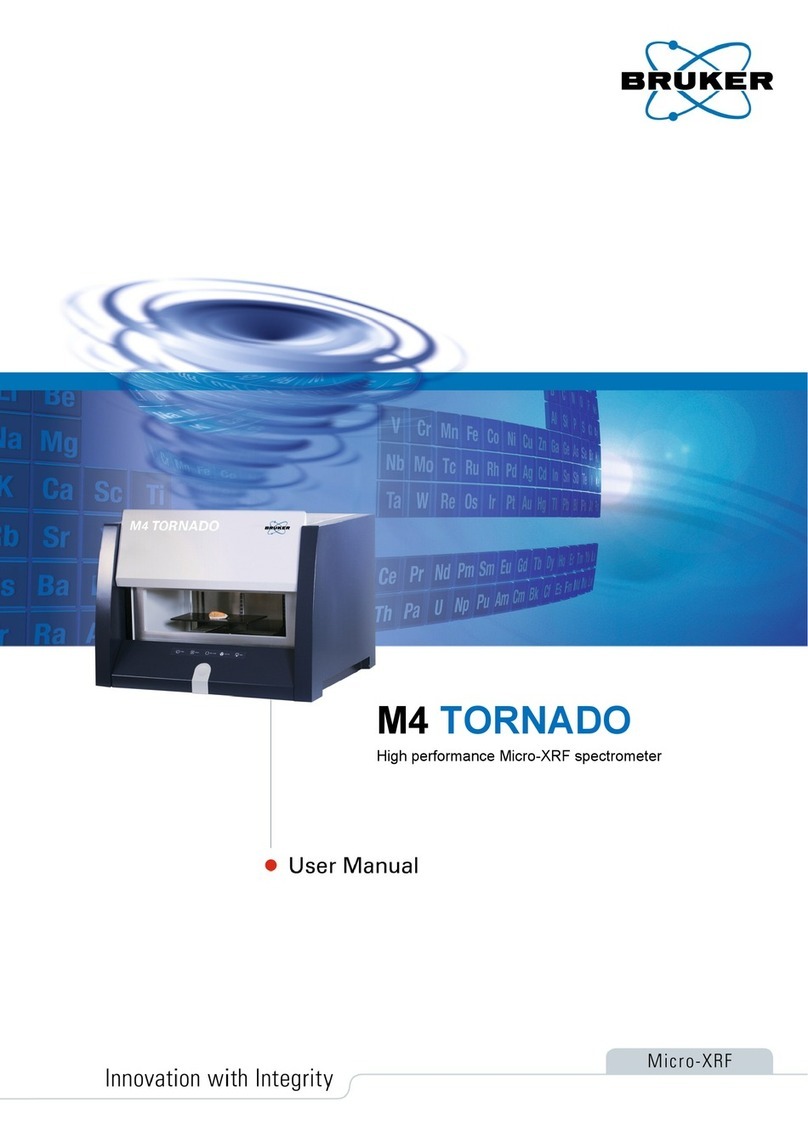
Bruker
Bruker M4 TORNADO user manual
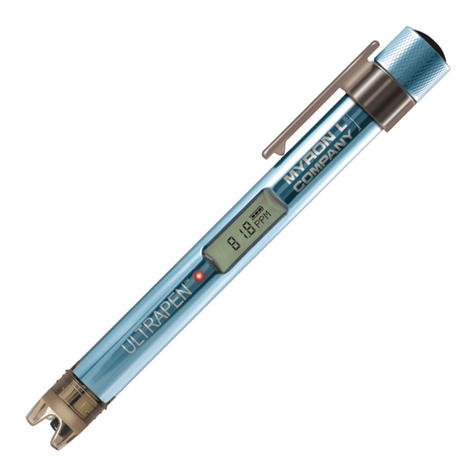
Myron L
Myron L Ultrapen PT6 Operation manual
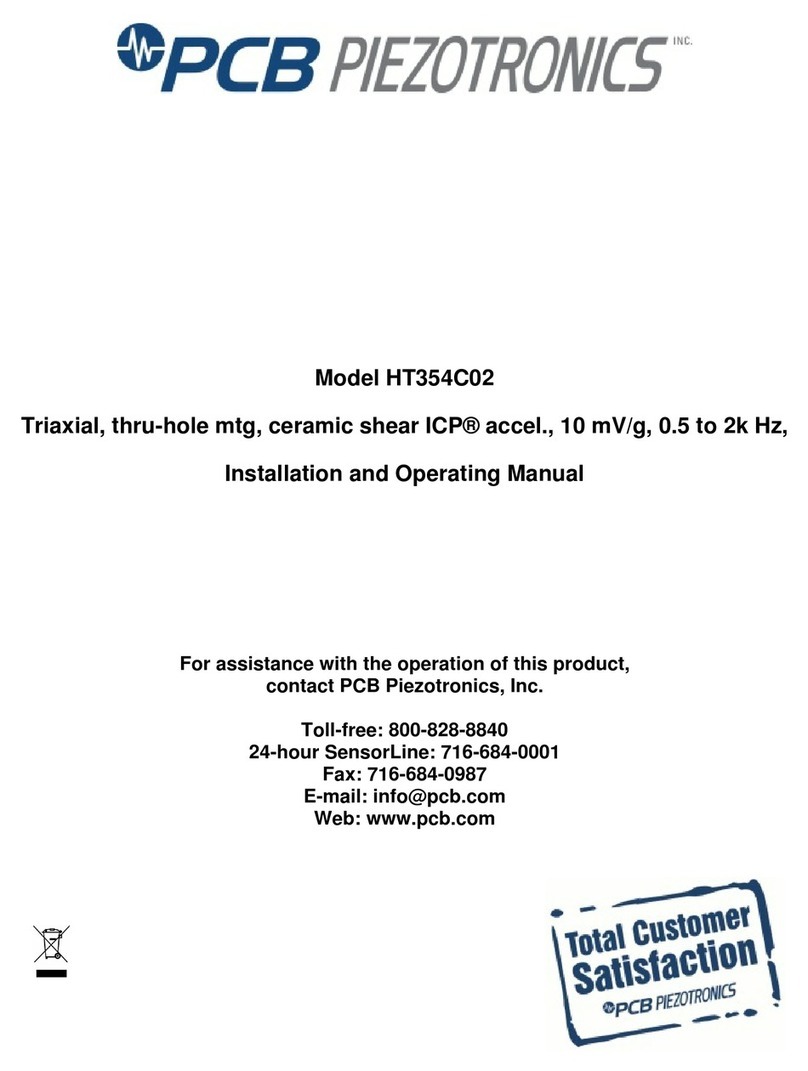
PCB Piezotronics
PCB Piezotronics HT354C02 Installation and operating manual
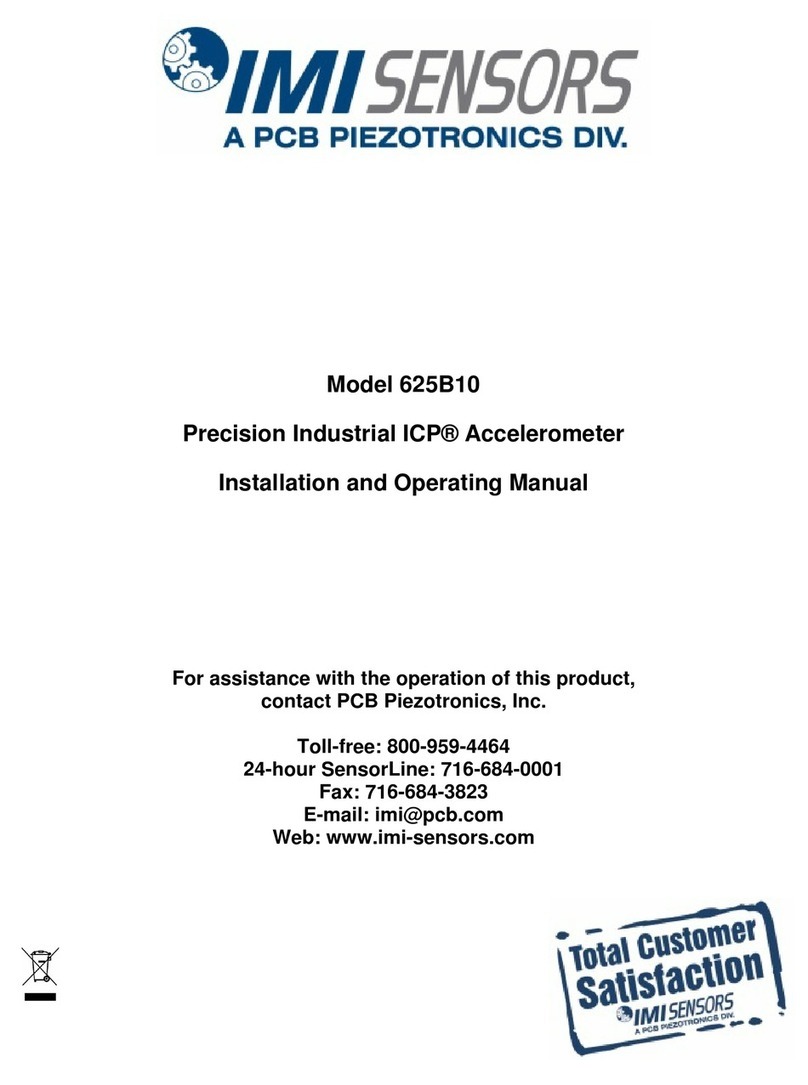
PCB Piezotronics
PCB Piezotronics IMI SENSORS 625B10 Installation and operating manual

PCB Piezotronics
PCB Piezotronics IMI Sensors 603C11/015BZ Installation and operating manual

Envertech
Envertech EVT400 Quick installation guide
